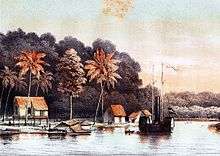Banjarmasin War
| Banjarmasin War | |||||||
|---|---|---|---|---|---|---|---|
| Part of Military Campaigns of the Dutch Empire | |||||||
 The steamship Celebes fighting with armed Dayak vessels | |||||||
| |||||||
| Belligerents | |||||||
|
| Sultanate of Banjarmasin | ||||||
| Commanders and leaders | |||||||
|
Colonel AJ Andresen Lieutenant-Colonel GM Verspyck |
Demang Lehman Amin Ullah | ||||||
The Banjarmasin War (in old spelling Bandjermasin War, Dutch "Expeditie naar de Zuider- en Oosterafdeling van Borneo") (1859–1863) was a colonial war for the restoration of Dutch authority in the eastern and southern section of Borneo.
Background
17th century
Since 1606 the East United India Company maintained contacts with the island of Borneo. In 1635 the first contract was signed with the Sultanate of Banjarmasin for the provision of pepper - at the time, a luxury product in Europe and a major reason for the Dutch interest in this region.
In following decades there were several skirmishes and armed clashes, especially related to such pepper contracts being unfulfilled. One of the most serious was the 1638 killing of 64 Dutch and 21 of their Japanese partners, at Kota Waring in Bandjermasin.
Early 19th century
In 1809 Herman Willem Daendels, then governor of the Dutch East Indies, decided to abandon Bandjermasin, as maintaining a presence there was considered uneconomical. However, in 1811 the British, who took over the islands in the context of the Napoleonic wars, established a presence there, notably in Alexander Hare who established an independent state of Maluka on the S.Maluka river which runs into the Java Sea not far S.E. of the Barito.
In December 1816, British authority returned to the Dutch, who signed a new contract with the Sultan. Though he continued to reign, in January 1817 the Sultan's flag was replaced by the Dutch one. Effective power in the Sultanate was increasingly taken up by the Dutch Resident.
Following years were marked by multiple small revolts, and by further unequal contracts being signed.
Succession Crisis


In 1852 the Sultan's heir-apparent died, and the Dutch replaced him by the illegitimate grandson Tamjied Illah.
In vain, Sultan Adam and many nobles in 1853 sent an embassy to Batavia, pointing out iniquities perpetrated by the Dutch-designated heir and appealing for the Dutch to recognise instead Hidayatullah - a younger but legitimate son.
Sultan Adam died in 1857 and was succeeded by the illegitimate Tamjied Illah. There ensued a struggle for power between Tamjied Illah and Hidayatullah, which divided the population, much of which stood behind Hidayatullah and highly resented the Dutch sponsoring of Tamjied Illah.
The Dutch Resident proved unfit for his job, underestimating the signs of an approaching uprising. The resistance of the population soon turned against Dutch authority, and began to take shape of a religious war.
The fear and powerlessness of Tamjied Illah fed the riots, which assumed large dimensions. In response, the Dutch government embarked on intervention, sending Colonel Augustus Johannes Andresen, who on 29 April 1859 assumed military command at to Bandjermasin. On 1 May he suspended the Resident and himself took up civil administration as well.
Sources
- 1936. Dr. J. Eisenberger. Kroniek der Zuider -en Oosterafdeling van Borneo. Liem Hwat Sing, Bandjermasin.
- 1892. Egbert Broer Kielstra. De ondergang van het Bandjermasinse Rijk. Overdruk uit de Indische Gids, jaargang 1891. E.J. Brill. Leiden.
- 1859. Wolter Robert van Hoëvell. De expeditie tegen Boni en de ramoen van Bandjermasin. Tijdschrift voor Nederlands Indie. 21 ste jaargang
- 1886. H.G.J.L. Meyners Bijdragen tot de geschiedenis van het Bandjermasinsche Rijk. 1863-1866. E.J. Brill. Leiden
- 1865. Willem Adriaan van Rees. De Bandjermasinse Krijg. 1859-1863. Twee delen. D.A. Thieme. Arnhem.
- 1867. W.A. van Rees. De Bandjermasinsche Krijg van 1859-1863 nader toegelicht. D.A. Thieme. Arnhem.
- 1897. J.P. Schoemaker. Verhalen uit de grote en kleine oorlog in Nederlands Indië. W.P. van Stockum & Zoon. Den Haag.
| Wikimedia Commons has media related to Banjarmasin War. |